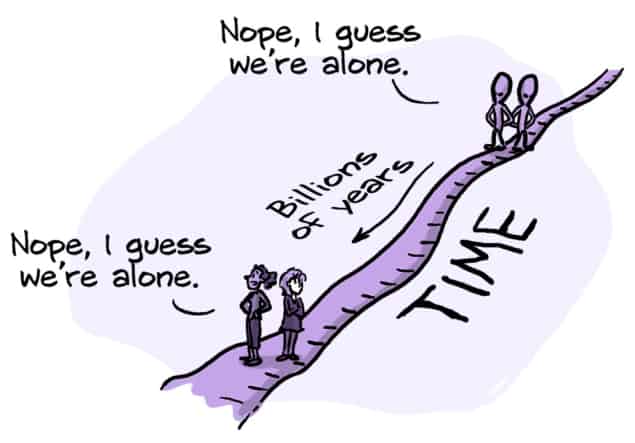Aatish Bhatia reviews We Have No Idea by Jorge Cham and Daniel Whiteson

Years ago, when I was a college student back home on vacation, my grandfather asked me a disarmingly simple question. “Why does –1 multiplied by itself equal 1?” He enjoyed these kinds of puzzles, and was asking from a place of genuine curiosity. I remember being taken aback by the simplicity of the question. This was just a fact about numbers that I took for granted – I’d never realized it could be questioned. Feeling pressured to come up with an answer, I struggled for a quick explanation, and spouted some jargonesque nonsense like “That’s just the definition… –1 is the multiplicative inverse of itself.” My grandfather gently let me know that this jumble of complicated sounding words did not constitute an explanation and I retreated to my room somewhat dejected. After thinking about it for a while, I came up with an answer that satisfied (indeed, delighted) him. You start with 1 + (–1) = 0, then multiply both sides by –1, and distribute. This leads you to realize that indeed –1 times itself is 1.
I hold on to three lessons from that encounter. First, that there’s a difference between jargon and understanding – a fancy-sounding word can be an easy place to hide your ignorance. Second, that you’re allowed to question things that others might take for granted. There’s even a certain joy and pleasure in doing so, and in seeing where it leads you. And last, that there’s no shame in not knowing, but there is shame in pretending that you know something you don’t. Which brings me to why I loved We Have No Idea by Jorge Cham – the artist behind the popular PHD Comics – and particle physicist Daniel Whiteson of the University of California, Irvine, US. This isn’t a book about things that we already know. Instead, it bills itself as “a guide to the unknown universe”. It’s a kind of encyclopedia of ignorance, shining a light on the nebulous boundaries between our species’ knowledge and our ignorance.
The first chapter asks why the universe follows “the Lego philosophy”, where everything in it (well, everything that we can touch and see… dark matter is a story for chapter two) is built from fundamental building blocks. At first, this might not seem like a question worth asking, but when you stop to think about it, as Cham and Whiteson do, you realize it’s a surprising fact about our world that warrants an explanation. In a later chapter, they puzzle about how strange it is that the quarks inside an atom have perfectly fractional charges (+2/3 and –1/3, not a tiny bit more or less) that can cancel each other out exactly. We have no idea why things are this way, but without this perfect cancellation we wouldn’t have neutral atoms, and stars and galaxies (and therefore you or I) would never have existed.
Some of my favourite questions in this book are the kind that I never stopped to think about. Why can we see so far through space? Why does the universe have a speed limit? Like jolts of caffeine, these questions shake the reader out of the mundaneness of everyday life, urging us to remark on the strange set of accidents and circumstances that led to us even being here in the first place. Through these questions, Whiteson and Cham zoom out from our everyday existence, bringing us up to the boundaries of human knowledge, and hand us a spacesuit to go exploring. The duo are frequently hilarious and deeply charming guides, offering up delightful illustrations and metaphors, oodles of puns and a fart joke or two thrown in for good measure.
In a book titled Why Don’t Students Like School?, the psychologist and educator Daniel Willingham writes, “Sometimes I think that we, as teachers, are so eager to get to the answers that we do not devote sufficient time to developing the question.” The same advice holds true for writing. One of the marks of great science writing is taking the time to develop a question. To let the size of a mystery sink into a reader’s mind before attempting an answer. Be it in questioning what space, time or mass really is; why we’re being bombarded with ludicrously high-energy particles from outer space; or even why the universe is so absurdly big, We Have No Idea excels in this measure. Rather than simply shrug their shoulders and accept that this is how the world works, the authors embrace these questions, and take them to heart.
While this is a book about the unknown, shining a light on ignorance is a clever way of explaining what we do in fact know. The book offers no easy answers, but is filled with many lucid explanations. Through stories such as the bag of beans in “Jack and the Beanstalk” to explain mass and binding energy, or an intricate scenario involving space hamsters and nerf guns to explain the theory of relativity, this book uses charming (though occasionally elaborate) analogies and witty cartoons to explain complex ideas.
The explanations are the kind that my grandfather would have loved, and I think you might too. The cartoons and jokes on nearly every page might make the book look deceptively simple, but it’s quite a feat to explain subtle ideas such as dark matter, the Big Bang and the evolution of the universe without resorting to physics technobabble. This is perhaps the book’s most impressive success. It embraces ignorance when it’s appropriate, and doesn’t hide ignorance in a buzzword. In so doing, this book is that rarest of things: genuinely honest. The philosophy is perhaps best summed up when the authors write, “We are both clueless and surrounded by clues.”
- 2017 John Murray 368pp £16.99hb


